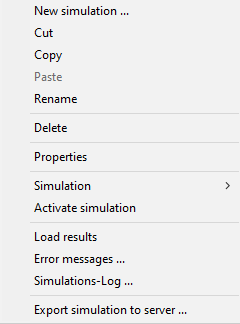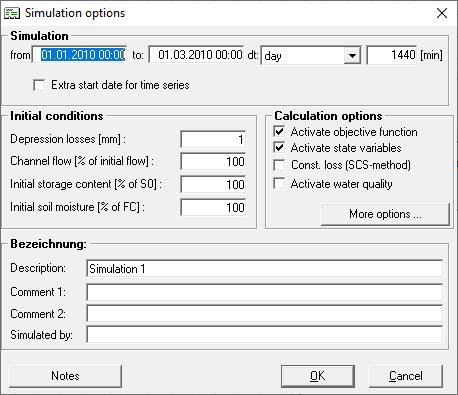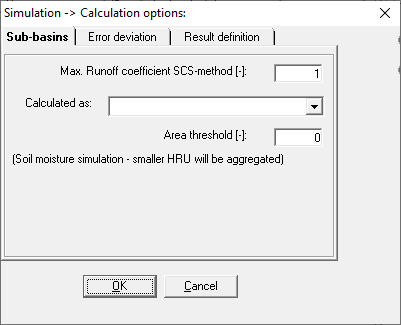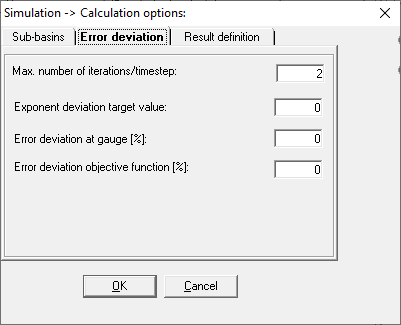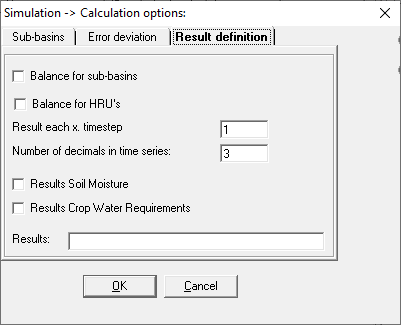Bereich Simulationen/en: Unterschied zwischen den Versionen
Ferrao (Diskussion | Beiträge) (Die Seite wurde neu angelegt: „A new simulation is created by right-clicking in the Simulations area and selecting ''Create new simulation'' from the context menu. In a newly created simulat…“) |
Keine Bearbeitungszusammenfassung |
||
| (70 dazwischenliegende Versionen von 2 Benutzern werden nicht angezeigt) | |||
| Zeile 4: | Zeile 4: | ||
__TOC__ | __TOC__ | ||
[[Datei: | [[Datei:Benutzeroberfläche00031_EN.png|Datei:Benutzeroberfläche00031_EN.png]] | ||
A simulation is automatically created in the | A simulation is automatically created in the project manager, when a scenario is [[Special:MyLanguage/Bereich_Simulationen#Neue Variante anlegen|created]], [[Special:MyLanguage/Bereich_Simulationen#Variante kopieren|copied]] or [[Special:MyLanguage/Bereich_Simulationen#Variante importieren|imported]]. When creating a new scenario, an empty simulation is created, whereas when copying or importing a scenario, the settings (e.g. simulation period) of the original simulation are adopted. To add a new simulation to an existing scenario, you can either create a [[Special:MyLanguage/Bereich_Simulationen#Neue Simulation anlegen|new simulation]] or add an already existing simulation through [[Special:MyLanguage/Bereich_Simulationen#Simulation kopieren|copy]] and [[Special:MyLanguage/Bereich_Simulationen#Simulation einfügen|paste]]. | ||
When running a simulation, input variables and results are stored in the simulation and can be viewed via '''load results'''. It is recommended not to change the flow network map when executing several simulations in one scenario, but to only to change simulation settings or to adjust single parameters or input variables and to document the adjustments. | |||
The following columns are filled for each simulation: | The following columns are filled for each simulation: | ||
| Zeile 14: | Zeile 14: | ||
{| class="wikitable" | {| class="wikitable" | ||
|- | |- | ||
|''' | |'''Name''' ||Name of the simulation. It is important to choose a clearly identifiable name e.g. used calibration parameters or changes in the flow network. | ||
|- | |- | ||
|'''ID''' ||Identification number of a simulation. | |'''ID''' ||Identification number of a simulation. When evaluating simulations, it is recommended to always note the simulation ID, in order to quickly find the corresponding scenario and simulation when working on large projects. | ||
|- | |- | ||
|'''Simulated on''' ||Date and time on which the simulation was | |'''Simulated on''' ||Date and time on which the simulation was run. | ||
|- | |- | ||
|'''from''' ||Date and time of simulation start | |'''from''' ||Date and time of simulation start. | ||
|- | |- | ||
|'''to''' ||Date and time of simulation end | |'''to''' ||Date and time of simulation end. | ||
|- | |- | ||
|} | |} | ||
| Zeile 30: | Zeile 30: | ||
Right-click on the simulation name to open the following context menu: | Right-click on the simulation name to open the following context menu: | ||
[[Datei: | [[Datei:Kontextmenü_Simulation_EN.png|Datei:Kontextmenü_Simulation_EN.png]] | ||
{| class="wikitable" | {| class="wikitable" | ||
|- | |- | ||
|'''[[Special:MyLanguage/#neue-simulation anlegen| | |'''[[Special:MyLanguage/#neue-simulation anlegen|New simulation]]''' ||A new, empty, and inactive simulation is created. | ||
|- | |- | ||
|'''[[Special:MyLanguage/#simulation-ausschneiden|Cut]]''' ||The selected simulation is cut out and can be | |'''[[Special:MyLanguage/#simulation-ausschneiden|Cut]]''' ||The selected simulation is cut out and can be pasted to another scenario. | ||
|- | |- | ||
|'''[[Special:MyLanguage/#simulation-kopieren|Copy]]''' ||The selected simulation is copied and can be pasted | |'''[[Special:MyLanguage/#simulation-kopieren|Copy]]''' ||The selected simulation is copied and can be pasted to the current or any other scenario. | ||
|- | |- | ||
|'''[[Special:MyLanguage/#simulation-einfügen|Paste]]''' ||After | |'''[[Special:MyLanguage/#simulation-einfügen|Paste]]''' ||After having cut or copied a simulation, it is inserted in the selected scenario. | ||
|- | |- | ||
|'''[[Special:MyLanguage/#simulation-umbenennen|Rename]]''' ||The name of the selected simulation can be changed. | |'''[[Special:MyLanguage/#simulation-umbenennen|Rename]]''' ||The name of the selected simulation can be changed. | ||
|- | |- | ||
|'''[[Special:MyLanguage/#simulation-löschen|Delete]]''' ||The selected simulation is deleted. This operation cannot be undone. Caution: If the activated simulation has been deleted, the | |'''[[Special:MyLanguage/#simulation-löschen|Delete]]''' ||The selected simulation is deleted. This operation cannot be undone. Caution: If the activated simulation has been deleted, the scenario cannot be copied or exported before activating another simulation. | ||
|- | |- | ||
|'''[[Special:MyLanguage/#simulation-editieren| | |'''[[Special:MyLanguage/#simulation-editieren|Properties]]''' ||A window, in which the simulation settings can be edited, opens. | ||
|- | |- | ||
|'''[[Special:MyLanguage/#untermenü-simulation|Simulation]]''' ||Further submenu items | |'''[[Special:MyLanguage/#untermenü-simulation|Simulation]]''' ||Further submenu items appear: <br/> [[Datei:Kontextmenü_Simulation_Simulation_EN.png|Datei:Kontextmenü_Simulation_Simulation_EN.png]] [[Datei:Kontextmenü_Simulation_Anfangsbedingungen_EN.png|Datei:Kontextmenü_Simulation_Anfangsbedingungen_EN.png]] | ||
|- | |- | ||
|'''[[Special:MyLanguage/#simulation-aktivieren|Activate simulation]] ''' ||The selected simulation becomes the active simulation ([[Datei: Benutzeroberfläche00029.png|Datei: Benutzeroberfläche00029.png]]). When exporting a | |'''[[Special:MyLanguage/#simulation-aktivieren|Activate simulation]] ''' ||The selected simulation becomes the active simulation ([[Datei: Benutzeroberfläche00029.png|Datei: Benutzeroberfläche00029.png]]). When exporting a scenario to the server, the results of the active simulation are uploaded. | ||
|- | |- | ||
|'''[[Special:MyLanguage/#fehlermeldungen|Error messages]]''' || | |'''[[Special:MyLanguage/#fehlermeldungen|Error messages]]''' || | ||
|- | |- | ||
|'''[[Special:MyLanguage/#simulations-log| | |'''[[Special:MyLanguage/#simulations-log|Simulations-Log]]''' || | ||
|- | |- | ||
|'''[[Special:MyLanguage/#simulation-zum server exportieren|Export simulation to server]]''' ||The results of the selected simulation are exported to the server and assigned to a | |'''[[Special:MyLanguage/#simulation-zum server exportieren|Export simulation to server]]''' ||The results of the selected simulation are exported to the server and assigned to a scenario. | ||
|- | |- | ||
| Zeile 64: | Zeile 64: | ||
<span id="neue-simulation anlegen"></span> | <span id="neue-simulation anlegen"></span> | ||
==Create | ==Create New Simulation== | ||
A new simulation is created by right-clicking in the | A new simulation is created by right-clicking in the simulations' section and selecting ''New simulation'' from the context menu. In a newly created simulation most settings are empty, however, some are filled with default values. A new simulation receives the default name ''New Simulation''. In order to adopt the simulation settings of another simulation, it is recommended to copy that simulation and paste it as a new simulation in the desired scenario. | ||
<span id="simulation-aktivieren"></span> | <span id="simulation-aktivieren"></span> | ||
==Simulation | == Activate Simulation== | ||
An active simulation is crucial when exporting and copying a scenario, as the settings and results of the active simulation are required to comlete the process. | |||
To activate the simulation, right-click on it and select ''Activate simulation''. The simulation labeled with the red check mark is the active simulation. | |||
<span id="simulation-editieren"></span> | <span id="simulation-editieren"></span> | ||
==Simulation | ==Edit Simulation== | ||
To edit the simulation settings, either right-click on the simulation and select ''Properties'' or double-click on the simulation. The following window will open: | |||
[[Datei: | [[Datei:Simulation003_EN.png|Datei:Simulation003_EN.png]] | ||
Under '''Simulation''', the simulation period in the format dd.mm.yyyy hh:mm, as well as the timestep, which can range between 1 minute and 1 month, are indicated. The timestep is automatically converted into minutes. For example, if you select a timestep of 1 day, it will be set to 1440 minutes. | |||
You can also make edits to the sections '''Initial conditions''' and '''Calculation options'''. | |||
Under '''Initial Conditions''', the initial conditions, which are set in the individual system elements, can be scaled globally. In addition to the '''Calculation options''', you can click on '''More options''' to open the following windows, in which you can define further information for the sub-basins, error deviations as well as result definitions. In the result definition window, you can define the resolution, in which you want to get the simulation results. For example, if your simulation timestep is 2 hours, but a result output on a daily basis is sufficient, enter 12 for '''Result each x. timestep'''. Then the result will only be indicated every 24 hours, as an average of the 12 calculated 2 -hour-values. | |||
[[Datei: | [[Datei:Simulation004_EN.png|Datei:Simulation004_EN.png]] [[Datei:Simulation005_EN.png|Datei:Simulation005_EN.png]] [[Datei:Simulation006_EN.png|Datei:Simulation006_EN.png]] | ||
Under Name you can rename the simulation and add a comment. | |||
<span id="simulation-kopieren"></span> | <span id="simulation-kopieren"></span> | ||
==Simulation | == Copy Simulation== | ||
To copy a simulation, either right-click on the simulation and select ''copy'' or select the simulation with a left-click and press Ctrl+C on the keyboard. All settings of the copied simulation are adopted. Results will not be copied. You can paste the copied simulation either in the same, or in a different scenario. Neither the scenario, nor the simulation must be active. | |||
<span id="simulation-ausschneiden"></span> | <span id="simulation-ausschneiden"></span> | ||
==Simulation | ==Cut Simulation== | ||
To cut a simulation, either right-click on the simulation and select ''cut'' or select the simulation with a left-click and press Ctrl+X on the keyboard. The complete simulation will be cut out of the scenario and, thus, deleted. The cut simulation can then be pasted into another scenario. Neither the scenario, nor the simulation must be active. | |||
''' | '''Caution:''' If you paste a cut simulation with results to another scenario, the results may not be in accordance with the new scenario, if the scenario has a different flow network map or different input parameters. | ||
<span id="simulation-einfügen"></span> | <span id="simulation-einfügen"></span> | ||
== | ==Insert simulation== | ||
A copied or cut simulation, can be pasted to a new scenario by right-clicking in the simulations' section and selecting ''paste'' or by using the key combination Ctrl+V. The scenario, in which you want to paste the new simulation, does not have to be active. | |||
''' | '''Caution:''' If you paste a cut simulation with results to another scenario, the results may not be in accordance with the new scenario, if the scenario has a different flow network map or different input parameters. | ||
<span id="simulation-umbenennen"></span> | <span id="simulation-umbenennen"></span> | ||
==Simulation | ==Rename Simulation== | ||
You can rename a simulation by right-clicking on the simulation and selecting ''rename'' or by double-clicking on it. | |||
<span id="simulation-löschen"></span> | <span id="simulation-löschen"></span> | ||
==Simulation | == Delete Simulation== | ||
To delete a simulation, right-click on the chosen simulation and select ''delete''. The simulation and all its results will be deleted irrevocably. | |||
<span id="simulation-zum server exportieren"></span> | <span id="simulation-zum server exportieren"></span> | ||
==Simulation | ==Export Simulation To Server== | ||
<span id="untermenü-simulation"></span> | <span id="untermenü-simulation"></span> | ||
== | == Submenu Simulation== | ||
=== | ===Start simulation=== | ||
By clicking the submenu item '''Start simulation''' the [[Special:MyLanguage/Fenster Simulation-Wizard|Simulation-Wizard window]], in which further simulation settings can be edited, appears. | |||
=== | ===Initial Conditions=== | ||
==== | ====Initial Storage Content==== | ||
==== | ====Write/Read Initial Conditions==== | ||
=== | ===Organize Results=== | ||
=== | ===Calibration=== | ||
<span id="fehlermeldungen"></span> | <span id="fehlermeldungen"></span> | ||
== | ==Error Messages== | ||
<span id="simulations-log"></span> | <span id="simulations-log"></span> | ||
==Simulations-Log== | ==Simulations-Log== | ||
Aktuelle Version vom 27. November 2020, 13:11 Uhr
A simulation is automatically created in the project manager, when a scenario is created, copied or imported. When creating a new scenario, an empty simulation is created, whereas when copying or importing a scenario, the settings (e.g. simulation period) of the original simulation are adopted. To add a new simulation to an existing scenario, you can either create a new simulation or add an already existing simulation through copy and paste.
When running a simulation, input variables and results are stored in the simulation and can be viewed via load results. It is recommended not to change the flow network map when executing several simulations in one scenario, but to only to change simulation settings or to adjust single parameters or input variables and to document the adjustments.
The following columns are filled for each simulation:
| Name | Name of the simulation. It is important to choose a clearly identifiable name e.g. used calibration parameters or changes in the flow network. |
| ID | Identification number of a simulation. When evaluating simulations, it is recommended to always note the simulation ID, in order to quickly find the corresponding scenario and simulation when working on large projects. |
| Simulated on | Date and time on which the simulation was run. |
| from | Date and time of simulation start. |
| to | Date and time of simulation end. |
Right-click on the simulation name to open the following context menu:
| New simulation | A new, empty, and inactive simulation is created. |
| Cut | The selected simulation is cut out and can be pasted to another scenario. |
| Copy | The selected simulation is copied and can be pasted to the current or any other scenario. |
| Paste | After having cut or copied a simulation, it is inserted in the selected scenario. |
| Rename | The name of the selected simulation can be changed. |
| Delete | The selected simulation is deleted. This operation cannot be undone. Caution: If the activated simulation has been deleted, the scenario cannot be copied or exported before activating another simulation. |
| Properties | A window, in which the simulation settings can be edited, opens. |
| Simulation | Further submenu items appear:  
|
| Activate simulation | The selected simulation becomes the active simulation ( |
| Error messages | |
| Simulations-Log | |
| Export simulation to server | The results of the selected simulation are exported to the server and assigned to a scenario. |
Create New Simulation
A new simulation is created by right-clicking in the simulations' section and selecting New simulation from the context menu. In a newly created simulation most settings are empty, however, some are filled with default values. A new simulation receives the default name New Simulation. In order to adopt the simulation settings of another simulation, it is recommended to copy that simulation and paste it as a new simulation in the desired scenario.
Activate Simulation
An active simulation is crucial when exporting and copying a scenario, as the settings and results of the active simulation are required to comlete the process. To activate the simulation, right-click on it and select Activate simulation. The simulation labeled with the red check mark is the active simulation.
Edit Simulation
To edit the simulation settings, either right-click on the simulation and select Properties or double-click on the simulation. The following window will open:
Under Simulation, the simulation period in the format dd.mm.yyyy hh:mm, as well as the timestep, which can range between 1 minute and 1 month, are indicated. The timestep is automatically converted into minutes. For example, if you select a timestep of 1 day, it will be set to 1440 minutes.
You can also make edits to the sections Initial conditions and Calculation options. Under Initial Conditions, the initial conditions, which are set in the individual system elements, can be scaled globally. In addition to the Calculation options, you can click on More options to open the following windows, in which you can define further information for the sub-basins, error deviations as well as result definitions. In the result definition window, you can define the resolution, in which you want to get the simulation results. For example, if your simulation timestep is 2 hours, but a result output on a daily basis is sufficient, enter 12 for Result each x. timestep. Then the result will only be indicated every 24 hours, as an average of the 12 calculated 2 -hour-values.
Under Name you can rename the simulation and add a comment.
Copy Simulation
To copy a simulation, either right-click on the simulation and select copy or select the simulation with a left-click and press Ctrl+C on the keyboard. All settings of the copied simulation are adopted. Results will not be copied. You can paste the copied simulation either in the same, or in a different scenario. Neither the scenario, nor the simulation must be active.
Cut Simulation
To cut a simulation, either right-click on the simulation and select cut or select the simulation with a left-click and press Ctrl+X on the keyboard. The complete simulation will be cut out of the scenario and, thus, deleted. The cut simulation can then be pasted into another scenario. Neither the scenario, nor the simulation must be active.
Caution: If you paste a cut simulation with results to another scenario, the results may not be in accordance with the new scenario, if the scenario has a different flow network map or different input parameters.
Insert simulation
A copied or cut simulation, can be pasted to a new scenario by right-clicking in the simulations' section and selecting paste or by using the key combination Ctrl+V. The scenario, in which you want to paste the new simulation, does not have to be active.
Caution: If you paste a cut simulation with results to another scenario, the results may not be in accordance with the new scenario, if the scenario has a different flow network map or different input parameters.
Rename Simulation
You can rename a simulation by right-clicking on the simulation and selecting rename or by double-clicking on it.
Delete Simulation
To delete a simulation, right-click on the chosen simulation and select delete. The simulation and all its results will be deleted irrevocably.
Export Simulation To Server
Start simulation
By clicking the submenu item Start simulation the Simulation-Wizard window, in which further simulation settings can be edited, appears.
Initial Conditions
Initial Storage Content
Write/Read Initial Conditions
Organize Results
Calibration
Error Messages

